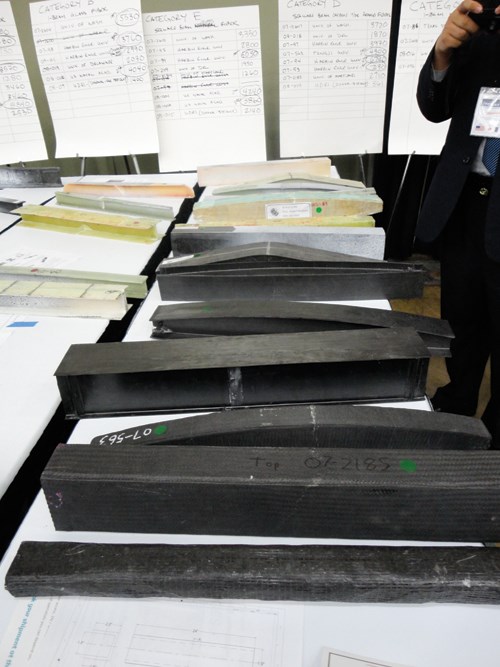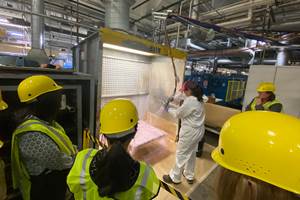SAMPE 2012 Report
The Society’s return to Baltimore is a boost to the advanced materials community and an occasion for interesting industry buzz.
SAMPE 2012, the world’s largest conference and exhibition for advanced materials and processes (M&P), held May 23-25 in Baltimore, Md., met with what show organizers saw as encouraging success. “Our decision to return to Baltimore has paid off,” noted Gregg Balko, executive director of the show’s host, the Society for the Advancement of Material and Process Engineering (SAMPE, Covina, Calif.). The statistics supported that view: The event attracted a total of 4,170 attendees from 30 countries and 47 U.S. states to a show floor on which 350 exhibitors were waiting.
“SAMPE is a truly global association and SAMPE 2012 is a great demonstration of our international appeal and relevance,” contended Dr. Tony Vizzini, SAMPE president and dean of the College of Engineering and Applied Sciences at Western Michigan University. “We’re pleased that our return to Baltimore has been such a great success.”
“This event exceeded expectations with the sold-out exhibit hall and 80 new exhibiting companies,” said Balko.
With a full hall and so many first-time exhibitors, the event’s energy appeared to bode well for the composites industry, at least for the near future. Moreover, the technical program featuring 300 presentations, distinguished lectures, panels and sessions that explored recent applications and research developments in M&P, there was no shortage of educational, networking and business opportunities for attendees.
Growing and changing
Growth and technology advancement created most of the buzz in the Baltimore Convention Center.
Given the event’s proximity to Washington, D.C., organizers capitalized on policy knowledge related to materials. Tuesday morning’s keynote speaker, Dr. Cyrus Wadia, assistant director of Clean Energy and Materials R&D for the White House Office of Science and Technology Policy, described the Obama Administration’s Materials Genome Initiative (MGI), a program aimed at getting new material concepts to market faster. With a tag line of “2X faster and 2X cheaper,” the MGI, which includes SAMPE as a forum member, is focused on more open data sharing, public/private partnerships and greater use of “informatics,” or application of information technology to materials research. The MGI, it turns out, is not just a conceptual program. Firehole Composites (Laramie, Wyo.) reported at SAMPE that it has begun working through the program with the U.S. Air Force Resource Lab, Convergent (Vancouver, British Columbia, Canada) and the University of Dayton on a four-year program to develop a software system that provides virtual testing of composite coupons. If this effort proves successful, says Firehole, virtual testing of finished parts will follow. The goal is to ensure that virtual data is supported by real-world results.
A panel later on Tuesday, organized by Ted Lynch, president and CEO of Strategic Marketing Innovations (SMI, Washington, D.C.), brought together additional U.S. government officials who discussed the current state of advanced materials policy. The panel addressed federal support of advanced materials research and technology and potential funding support for the future. In a related panel, Tia Benson Tolle of Boeing Commercial Airplanes (Seattle, Wash.) moderated a group of industry and academic experts who discussed Integrated Computational Materials Science and Engineering (ICMSE), a discipline that seeks to integrate computation and information technologies with materials development to dramatically accelerate the time frame for materials development and deployment.
Wednesday’s keynoter was Larry Ilcewicz, the chief scientific and technical advisor for composite materials at the Federal Aviation Admin. (FAA). After a review of aircraft composites usage through the years, Ilcewicz stressed that to fulfill his objective at FAA, which is to ensure safe deployment of composites technology on aircraft, he is partnering with industry to develop guidance, expand training programs and integrate design, manufacturing and maintenance for successful composite applications.
A full slate of technical papers and presentations offered information ranging from nanotechnology development, alternative energy and green materials, to structural health monitoring, testing and space materials. One of the featured lectures, by Dr. Mark Shuart, senior advisor for composites and structures at NASA Langley Research Center (Hampton, Va.), discussed NASA’s search for material systems with long out-times to enable out-of-autoclave processing for a heavy-lift launch vehicle with a projected 10m/32.5-ft diameter barrel, under NASA’s Composites for Exploration (CoEx) program. Thermoplastic materials and processing seemed to be a hot topic, as was emerging materials, such as new conductive polymers for coatings to replace metal foils/grids for lightning strike protection in composite airframes.
SAMPE is typically aerospace-focused, and 2012 was no exception. There was, however, much discussion on the show floor about carbon fiber’s migration into structural elements of production automobiles. First in line is automaker BMW’s (Munich, Germany) i3, coming in 2013, followed by the i8 in 2014. Both are benefiting from carbon fiber supplied by SGL Carbon SE (Wiesbaden, Germany). But the recently announced collaboration between General Motors (Detroit, Mich.) and TEIJIN ARAMID BV (Tokyo, Japan) to develop carbon fiber-reinforced thermoplastic automotive structures, using molding technology that reportedly can achieve a less than one-minute cycle time, also was a hot topic, but it did not overshadow the Ford Motor Co. (Dearborn, Mich.) and Dow Automotive Systems (Midland, Mich.) decision to join Oak Ridge National Laboratory (ORNL, Oak Ridge, Tenn.) in its effort to develop low-cost precursors that will enable production of much less expensive carbon fiber.
As it has in the past, SAMPE 2012 hosted the annual Student Bridge Competition, in which college students submit carbon, glass and natural fiber bridges for testing to failure. Student teams watched anxiously on the show floor as bridges were put through their paces, mounted in a testing machine.
Many of the usual schools submitted bridges this year, including the University of Delaware, the University of Washington, Brigham Young University (BYU), the U.S. Naval Academy and the University of Maryland. What was notable, however, was the strong showing of Chinese colleges, including Harbin Engineering University and Tongji University (see photo and captions at left)
Related Content
Pusan National University researchers introduce method to enhance thermally conductive composites
The proposed method has the potential to control the orientation of composite fillers without surface modification, improving thermal management.
Read MoreWomen in the Composites Industry brings together women for networking, educational opportunities
Aiming to support the growth of women in this industry, the WCI industry group and its partners recently held its first live training event hosted by Owens Corning.
Read MoreDaher inaugurates Learning Center for training aeronautical talent
Daher offers a concrete solution to the shortage of qualified professionals in aerospace, providing a range of technical programs that prepare workers for the sector’s rigorous demands.
Read MoreThe Native Lab launches composites course training membership plan
Courses that touch on the fundamentals of composite materials, design, analysis and more are available for individuals and companies alike through TNL’s online platform.
Read MoreRead Next
“Structured air” TPS safeguards composite structures
Powered by an 85% air/15% pure polyimide aerogel, Blueshift’s novel material system protects structures during transient thermal events from -200°C to beyond 2400°C for rockets, battery boxes and more.
Read MoreAll-recycled, needle-punched nonwoven CFRP slashes carbon footprint of Formula 2 seat
Dallara and Tenowo collaborate to produce a race-ready Formula 2 seat using recycled carbon fiber, reducing CO2 emissions by 97.5% compared to virgin materials.
Read MorePlant tour: Daher Shap’in TechCenter and composites production plant, Saint-Aignan-de-Grandlieu, France
Co-located R&D and production advance OOA thermosets, thermoplastics, welding, recycling and digital technologies for faster processing and certification of lighter, more sustainable composites.
Read More























